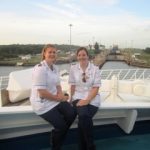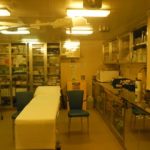Stacey Bonser, Registered Nurse, Adelaide
Cruise Ship Nursing
After working in emergency and critical care for several years, I spent the next 3 years working on cruise ships as a Registered Nurse for Princess Cruises between 2010 and 2013.With this experience I was able to travel the world and visit over 160 ports and cities in 50 countries.
Areas of the world that I sailed included Asia, Oceania, The Middle East, Mediterranean, Northern Europe, Caribbean, North and Central America.
The Cruise ships varied in size, some smaller vessels that carried approximately 1000 passengers and crew, with larger vessels carrying up to 5000 of passengers and crew. Typically the ratio of passengers to crew is 3:1. This in turn equated to the size of the medical centre and staffing for the medical team on board. The team would comprise of 1 or 2 Doctors, 2-4 nurses and on the larger vessels 2 paramedics. Working rotating rosters included 12 hour days and nights, or even longer hours if medical emergencies were to arise.
The Medical Facilities
The medical team is available 24 hours a day for emergencies and also has set clinic times for everyday concerns, such as coughs/colds, motion sickness, accidents and injuries for both passengers and crew. The centre is comprised of a clinic for outpatient care and a small hospital for patients to be admitted and treated if to unwell to return to their cabin.
Generally the care of the patient, if possible, would be to treat and stabilise them to continue the cruise. Otherwise in the unfortunate event, if critically ill the Senior Doctor makes the final decision whether to disembark the patient. This would be taking into consideration where the ship is sailing and if the hospital ashore in that country has adequate health care provisions.In more severe cases this could include helicopter evacuations of a patient, or discussing with the Captain the possibility of speeding the ship in order to reach the next location quicker or redirecting the ship to a closer port. All these actions would be for the best interest of the patient and how critical/ life threatening the incident may be.
The medical centre is equipped with central monitoring, defibrillator, ventilator, a wide range of supplies and medications. It includes a laboratory to run a wide range of blood tests and facilities to take x-rays. They even have the ability to cross match blood and be able to transfuse a patient if critically needed. Medications are able to be dispensed from the pharmacy after consultation.
If it is not a routine stocked item the doctor will try to obtain this from the next port or if necessary to use a similar medication that is stocked until then. Cost of health care on board can be expensive, as it is a privately run facility.
Australian Medicare, New Zealand ACC and private health insurance do not cover for any medical costs on board. All cruises (even cruises that do not visit foreign ports and stay within the ports of Australia) require international travel insurance. Consultations, treatments and medication are charged at private rates and must be paid by the customer and then later claimed through your travel insurance after the holiday.
How to prepare travellers for Cruise Ships:
- Advise to take up to date record of medical history and medications
- Pack Medications in hand luggage, with letter from GP or medical specialist
- Annual Influenza and up to date Whooping Cough Vaccine.
- Those over 65+ to have had pneumococcal Vaccine
- Check with Cruise line if any specialty vaccines required for Itinerary e.g. Yellow Fever or Hepatitis A and Typhoid if eating ashore in exotic ports.
Personal Medical Oxygen and Devices:
Passengers that require oxygen are to contact the ships medical department shore side to advise and arrange delivery of their personal oxygen cylinders and equipment. It is advisable that they take their own CPAP and nebuliser machines, along with all cables and adapters if needed (check with cruise company which adapters would be required) The medical facility has its own supply of oxygen for critical patients
Advice for Motion Sickness:
Prevention of Motion Sickness is easier than the treatment, so education and preparation is important especially if the passenger has suffered previously.
- The lower and more central in the ship the less movement you will feel
- Get fresh air, but keep your eyes on the horizon
- Eat light meals. Avoid dairy and fatty meals.
- Take prescription Medication if needed ( Avomine / Promethazine)
If prescription medication is needed, it is best to take this medication before sailing and preferably regular at night time if there are multiple sea days, as some medications can cause drowsiness. This can also be purchased at the medical centre if they don’t already have it. The ships medical facility can treat severe motion sickness with alternate medications if tablets have not eased symptoms.
I now work at the Travel-Bug Vaccination Clinic, in North Adelaide using my travel experience and knowledge to help plan and prepare travellers for their holidays. I remain in contact with Princess Cruises and now assist with recruitment and interviewing nurses who wish to work at sea. If this interests you or somebody you know, please contact me at pcl.nursingrecruitment@hotmail.com


